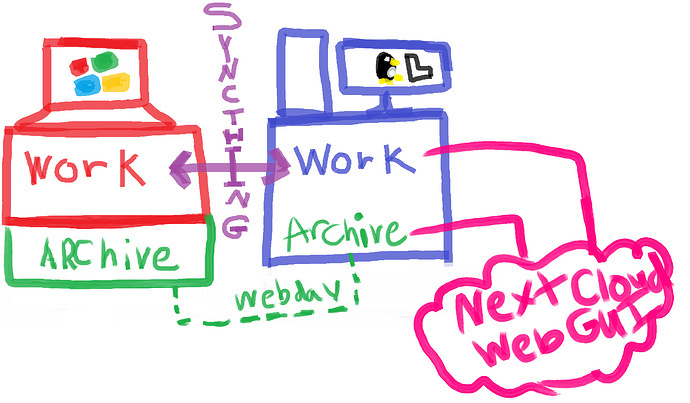

Within seconds, it automatically shows up on my computer at home and all of my other devices where I have set up Syncthing. If I need to make a note of something while I am at work, for example, I simply type into a Notes log file. I have a Notes directory that I sync across my devices. We will, however, be using Nextcloud as an alternative for iPhone support (see the next section). I am currently using an iPhone, and so far there is no support on that side, unfortunately.
Syncthing nextcloud android#
If you are running an Android phone, there is also an app available for that. I’ve got Syncthing set up on my MacBook Pro, my Windows 10-based workstation at home, and my LTE Surface Go. Syncthing is a very powerful open-source tool that lets you keep files up-to-date with changes made across multiple devices. This is a win for longevity of data, as you could easily find or search through files in the directory tree even decades from now and find what you want. No databases or complex structures are required here. In addition to its simple text-only format, it also has an advantage of being stored simply as files in a directory structure of your own choosing. Of course, you can use any editor you choose such as Emacs, or even those specifically designed for Markdown. I am currently using Visual Studio Code for note-taking because I enjoy it for writing code and it is available on practically any platform (macOS, Linux, Windows). This frees me from proprietary formats used by note-taking applications and allows me to use the editor of my choosing. I have switched to note-keeping using Markdown. We can achieve nearly the same convenience of cloud-based notes solutions with the privacy of our own network. Or in the case of paid services, your notes can essentially be held ransom until you pay to continue the service. If the cloud app/service decides to shut down, your notes are either gone, or you are forced to export them to another provider. In addition, you are subject to vendor lock-in. Storing your notes in a cloud provider might be convenient, but there are major privacy concerns, as I have mentioned before.

This is the third post in a series about protecting your privacy by self-hosting while attempting to maintain the conveniences of public cloud services. In this post, we’ll be setting up a privacy-focused alternative to cloud note-taking services like Apple Notes, Evernote, or Google Keep.
Syncthing nextcloud how to#
In my previous post, I described how to set up an SMB file server with automated backups using Rsync/Rclone.


 0 kommentar(er)
0 kommentar(er)
